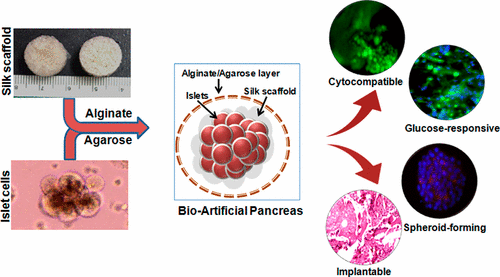当前位置:
X-MOL 学术
›
ACS Biomater. Sci. Eng.
›
论文详情
Our official English website, www.x-mol.net, welcomes your feedback! (Note: you will need to create a separate account there.)
Localized Immunomodulatory Silk Macrocapsules for Islet-like Spheroid Formation and Sustained Insulin Production
ACS Biomaterials Science & Engineering ( IF 5.8 ) Pub Date : 2017-08-30 00:00:00 , DOI: 10.1021/acsbiomaterials.7b00218 Manishekhar Kumar 1 , Samit K. Nandi 2 , David L. Kaplan 3 , Biman B. Mandal 1
ACS Biomaterials Science & Engineering ( IF 5.8 ) Pub Date : 2017-08-30 00:00:00 , DOI: 10.1021/acsbiomaterials.7b00218 Manishekhar Kumar 1 , Samit K. Nandi 2 , David L. Kaplan 3 , Biman B. Mandal 1
Affiliation

|
Pancreatic islet encapsulation in a 3D scaffolding matrix has achieved limited clinical success due to loss of islet function and cell death, shortly after transplantation. Also, transplant-associated inflammatory responses create an unfavorable microenvironment for islet survival. The current study delineates the development of cell-encapsulating immunomodulatory 3D silk scaffolds as bioartificial pancreas (BAP) systems for sustained insulin release. Insulin producing cells were encapsulated inside silk scaffolds with either alginate or agarose for immunoisolation to augment islet survival and function. The scaffolds were extensively characterized for pore architecture, porosity, swelling index, water uptake, and density. Further, suitability of these scaffolds was assessed through diverse in vitro tests, including cell adherence, viability, proliferation, 3D spheroid like pancreatic structures development, glucose stimulated insulin secretion, and macrophage polarization. Rat insulinoma (RIN-5) cells were metabolically active within the macroencapsulates and proliferated up to 2.5-fold over 5 weeks in culture. Cultured cells formed 3D islet-like spheroids spontaneously. Primary islets maintained their function in macroencapsulates with enhanced glucose stimulation index when compared to nonencapsulated islets, 1.2 vs 1.7. RT-qPCR and immunohistochemistry results supported the results obtained from glucose challenge assay. Controlled release profiles of anti-inflammatory cytokine interleukine-4 (IL-4) and dexamethasone evinced their prospective application in reducing local foreign body response and immunosuppression. Released IL-4 was biologically active and polarized M0 macrophages to the M2 phenotype, advocating immunosuppressive function. Reduced inflammatory responses illustrated the biocompatibility of these scaffolds. In conclusion, this novel biomaterial system was successfully used to encapsulate insulin-producing cells with enhanced cell functions. Further development of the system may have potential BAP applications.
中文翻译:

局部免疫调节丝绸大胶囊的胰岛样球体形成和胰岛素的持续生产。
由于胰岛功能丧失和细胞死亡,移植后不久,胰岛在3D支架基质中的封装已获得有限的临床成功。同样,移植相关的炎症反应为胰岛的生存创造了不利的微环境。当前的研究描述了细胞包裹的免疫调节3D丝支架作为生物人工胰腺(BAP)系统的持续胰岛素释放的发展。将产生胰岛素的细胞与藻酸盐或琼脂糖一起包裹在丝支架中,以进行免疫分离以增加胰岛的存活和功能。对支架的孔隙结构,孔隙率,溶胀指数,吸水率和密度进行了广泛表征。此外,通过各种体外评估这些支架的适用性测试包括细胞粘附,生存能力,增殖,3D球状胰腺结构发育,葡萄糖刺激的胰岛素分泌和巨噬细胞极化。大鼠胰岛素瘤(RIN-5)细胞在大囊体内具有代谢活性,并在培养5周内增殖达2.5倍。培养的细胞自发形成3D胰岛状球体。与未包囊的胰岛相比,原胰岛在葡萄糖刺激指数增强的大包囊中保持其功能,即1.2与1.7。RT-qPCR和免疫组织化学结果支持了从葡萄糖激发试验获得的结果。抗炎细胞因子白细胞介素4(IL-4)和地塞米松的控释特性证明了它们在减少局部异物反应和免疫抑制方面的前瞻性应用。释放的IL-4具有生物活性,并极化M0巨噬细胞至M2表型,提倡免疫抑制功能。减少的炎症反应说明了这些支架的生物相容性。总之,这种新颖的生物材料系统已成功用于封装具有增强细胞功能的胰岛素生产细胞。系统的进一步开发可能具有潜在的BAP应用程序。
更新日期:2017-08-31
中文翻译:

局部免疫调节丝绸大胶囊的胰岛样球体形成和胰岛素的持续生产。
由于胰岛功能丧失和细胞死亡,移植后不久,胰岛在3D支架基质中的封装已获得有限的临床成功。同样,移植相关的炎症反应为胰岛的生存创造了不利的微环境。当前的研究描述了细胞包裹的免疫调节3D丝支架作为生物人工胰腺(BAP)系统的持续胰岛素释放的发展。将产生胰岛素的细胞与藻酸盐或琼脂糖一起包裹在丝支架中,以进行免疫分离以增加胰岛的存活和功能。对支架的孔隙结构,孔隙率,溶胀指数,吸水率和密度进行了广泛表征。此外,通过各种体外评估这些支架的适用性测试包括细胞粘附,生存能力,增殖,3D球状胰腺结构发育,葡萄糖刺激的胰岛素分泌和巨噬细胞极化。大鼠胰岛素瘤(RIN-5)细胞在大囊体内具有代谢活性,并在培养5周内增殖达2.5倍。培养的细胞自发形成3D胰岛状球体。与未包囊的胰岛相比,原胰岛在葡萄糖刺激指数增强的大包囊中保持其功能,即1.2与1.7。RT-qPCR和免疫组织化学结果支持了从葡萄糖激发试验获得的结果。抗炎细胞因子白细胞介素4(IL-4)和地塞米松的控释特性证明了它们在减少局部异物反应和免疫抑制方面的前瞻性应用。释放的IL-4具有生物活性,并极化M0巨噬细胞至M2表型,提倡免疫抑制功能。减少的炎症反应说明了这些支架的生物相容性。总之,这种新颖的生物材料系统已成功用于封装具有增强细胞功能的胰岛素生产细胞。系统的进一步开发可能具有潜在的BAP应用程序。


























 京公网安备 11010802027423号
京公网安备 11010802027423号